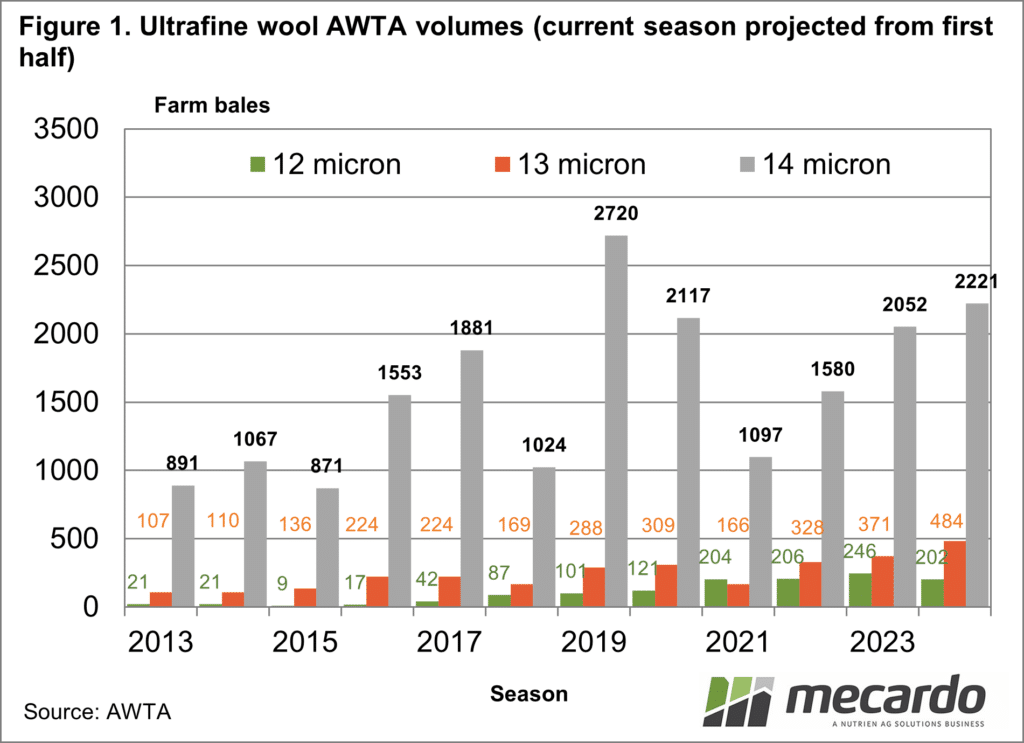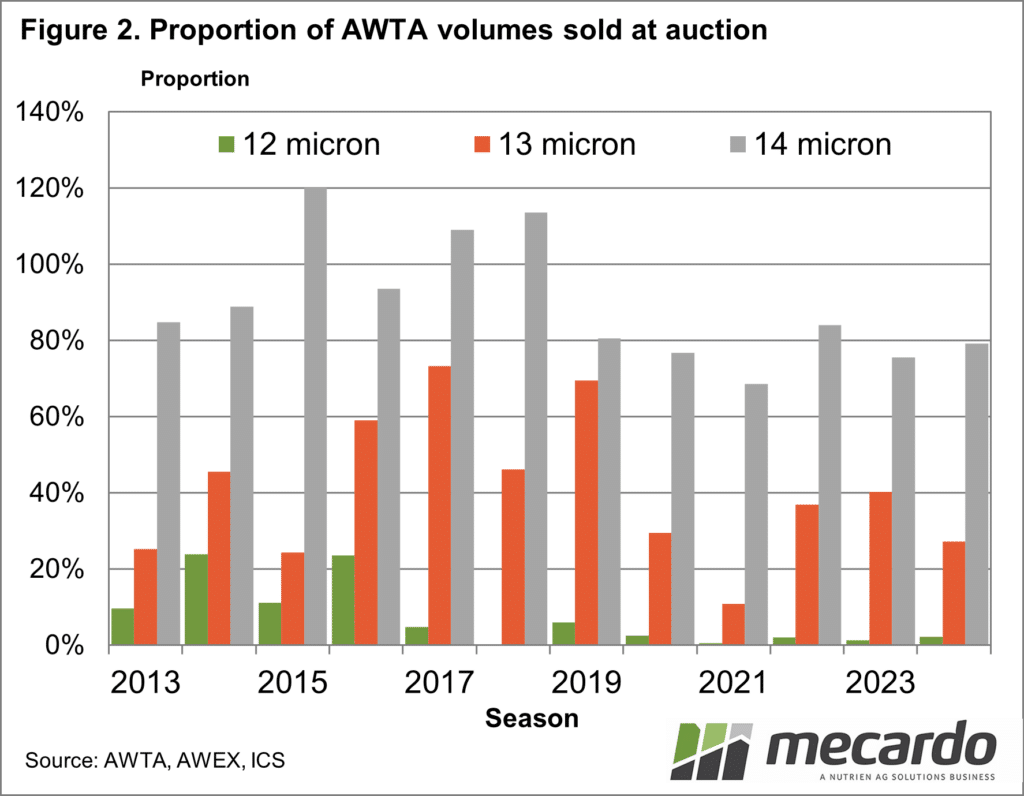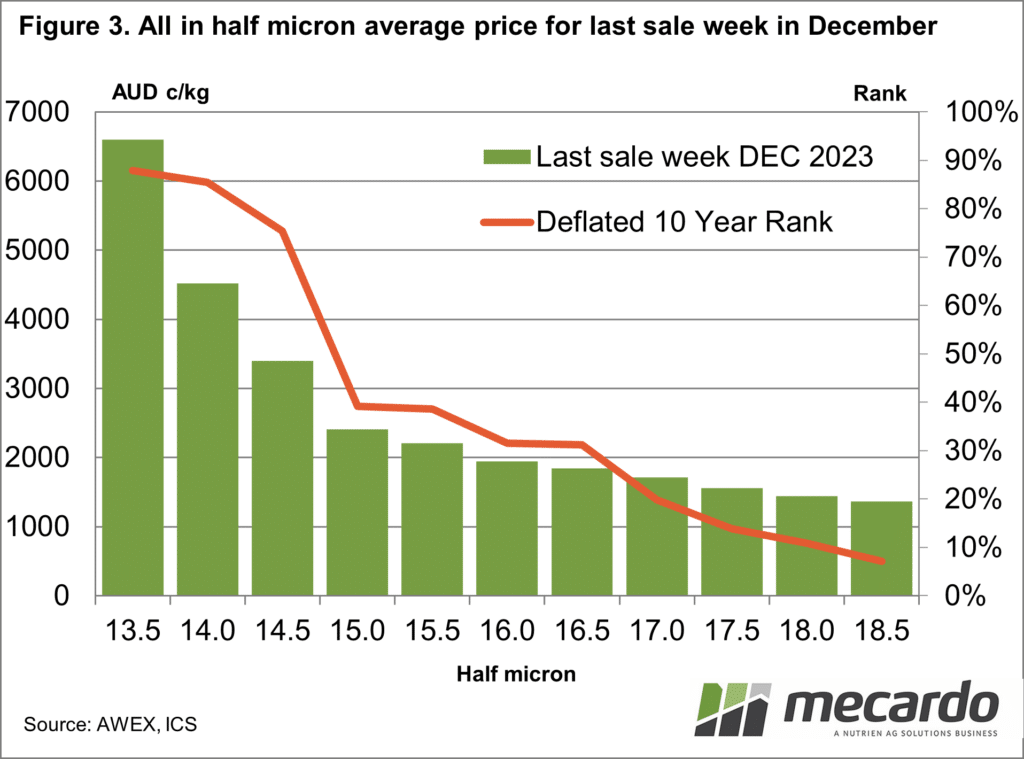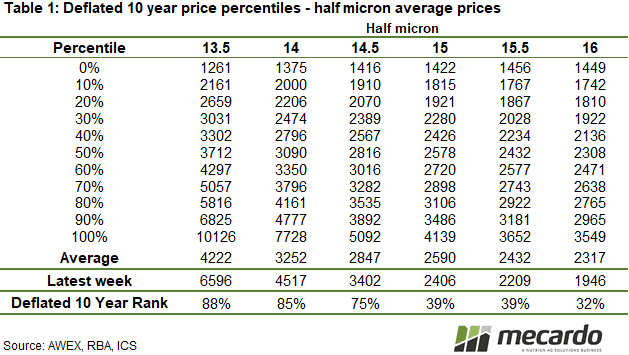Wool is a catchall term for a fibre that covers a wide range of qualities and uses. In this article, we look at the very fine end of the Merino micron distribution where despite improvements in supply, prices are tracking at excellent levels.
As a general rule around 85% of the
Australian fresh-shorn wool clip is sold at auction, providing an efficient,
transparent, and liquid market. There is also a substantial component of the
Australian wool clip which is exported on skins and the backs of live sheep
exports. In recent seasons this part of the Australian wool supply has amounted
to a 20-26% addition to the fresh-shorn wool supply, up from around 10% in the 1980s.
The very fine end of the Merino
distribution accounts for small volumes, but there is growth. Figure 1 shows
the AWTA volumes by season, for the past decade for 12 through to 14 micron. In
recent years the annual AWTA volumes for 12 micron have been around 200 farm
bales, for 13 micron 300-400 farm bales, and for 14 micron around 2000 farm
bales. Note that 12 micron volumes are up tenfold on the levels of a decade ago
(20 to 200 bales), 13 micron is up by three to four times and 14 micron has
doubled. It is good to see growth in this section of the wool industry.
General rules are subject to exceptions and
the 85% of fresh wool volumes going through auctions do not hold for the very
fine end of the Merinos. Figure 2 shows the proportion of AWTA volumes for 12
to 14 micron which were accounted for by auction sales for the past decade. Very
little 12 micron, effectively none in recent seasons, makes it to auction. For
13 micron, in recent seasons, only 20-40% has made it to auction. Most likely
it was the broader side of the 13 micron range (12.6 to 13.5) which was sold at
auction and the finer side sold directly outside of the auction system. In
recent seasons some 80% of 14 micron wool has been sold at auction, which is
close to the general 85% rule of thumb.
So, given the increases in Australian
supplies of 12-14 micron wool during the past decade how are prices faring?
Figure 3 shows the average price (all in) by half micron from 13.5 through to
18.5 micron for the last week of sales in December. A line is overlaid on the
graph which shows the deflated (inflation-adjusted) 10-year percentile rank for
this price.
As Figure 2 shows there is no useful sales
data for 12 micron. While the bigger volume micron categories of 17-18 micron
are tracking at low price rankings, the 13.5 through 14.5-micron categories are
in their upper quartiles. The increased Australian supply does not appear to be
affecting price much.
In Table 1 deflated 10-year price deciles
for simple half-micron averages (all in) from 13.5 to 16.0 micron are shown,
along with the average price for the last sale in December and its ranking. The
all-in nature of the averages includes all categories of wool, from stains to
spinners fleece, which gives rise to some wrinkles in the low-ranking
percentiles.
What does it mean?
While the bulk of the greasy wool market in Australia is transparent due to some 85% of the clip being sold at auction, which is well reported by AWEX, prices for the 13 micron and finer categories (which only account for around 600 farm bales per season) are somewhat of a mystery as much of this wool is sold privately.
Whatever prices are paid, they must be attractive as the supply has increased during the past decade with 12 micron volumes rising from around 20 bales to 200, and 13 micron volumes increasing by three to fourfold.
Have any questions or comments?
Key Points
- Effectively no Australian 12 micron wool is sold at auction, only 20-40% of 13 micron is sold at auction.
- The supply of 12 to 14 micron wool has increased substantially during the past decade.
- Despite large proportion increases in supply the price levels for 13-14 micron wool are tracking at high levels.
Click on figure to expand
Click on figure to expand
Click on figure to expand
Click on figure to expand
Data sources: AWTA, AWEX, RBA, ICS, Mecardo
















